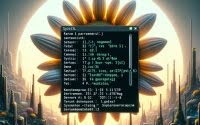Untar Linux Files with ‘tar -xvf’ Command | How-to Guide

Are you finding it challenging to untar files in Linux? You’re not alone. Many developers grapple with this task, but the ‘tar’ command can make this process a breeze. Like opening a sealed envelope, the ‘tar’ command in Linux helps you access the contents of tar files. These files can be easily managed on any Linux system, even those with minimal resources.
This guide will walk you through the process of decompressing files with the ‘tar’ command in Linux, from basic usage to advanced techniques. We’ll explore the ‘tar’ command’s core functionality, delve into its advanced features, and even discuss common issues and their solutions.
So, let’s dive in and start mastering untarring files in Linux
TL;DR: How Do I Untar Files in Linux?
To untar a file in Linux, use the
'tar -xvf'command followed by the filename,tar -xvf file.tar. This command extracts the contents of tar files, which are commonly used in Linux for file compression.
Here’s a simple example:
tar -xvf example.tar
# Output:
# file1
# file2
# file3
In this example, we use the ‘tar -xvf’ command to untar the ‘example.tar’ file. The command extracts the contents of ‘example.tar’, which in this case are ‘file1’, ‘file2’, and ‘file3’.
This is just the basic usage of the tar command in Linux. There’s much more to learn about handling tar files, including dealing with different types of tar files and troubleshooting common issues. Continue reading for more detailed information and advanced usage scenarios.
Table of Contents
- The Basics of the tar -xvf Command in Linux
- Advanced Usage of Untarring Files
- Exploring Alternative Untar Methods in Linux
- Troubleshooting Common Tar Command Issues in Linux
- Understanding File Compression and Decompression in Linux
- The Broader Picture: Tar Command Beyond File Extraction
- Wrapping Up: How to Untar Files in Linux
The Basics of the tar -xvf Command in Linux
The ‘tar -xvf’ command is the basic untar command in Linux. It’s a combination of three options: ‘x’ (extract), ‘v’ (verbose), and ‘f’ (file). Here’s what each option does:
- ‘x’: This option tells the tar command to extract the contents of a tar file.
- ‘v’: The verbose option enables the command to display the progress in the terminal as it extracts files.
- ‘f’: This option allows you to specify the name of the tar file.
Let’s see this command in action:
tar -xvf archive.tar
# Output:
# file1.txt
# file2.txt
# directory1
In this example, the ‘tar -xvf’ command extracts the contents of ‘archive.tar’, which are ‘file1.txt’, ‘file2.txt’, and ‘directory1’. The command displays these file names in the terminal as it extracts them, thanks to the ‘v’ option.
While the ‘tar -xvf’ command is a powerful tool, it’s not without its potential pitfalls. One common issue is that it will overwrite existing files without any warning. So, it’s always a good idea to check the contents of a tar file before extracting it, which you can do using the ‘tar -tvf’ command.
Advanced Usage of Untarring Files
As you get more comfortable with the basic ‘tar -xvf’ command, you can begin to explore its more advanced features. These include dealing with different types of tar files, such as .tar.gz or .tar.bz2, and how to untar them.
Before we dive into the advanced usage of the untar command, let’s familiarize ourselves with some of the command-line arguments or flags that can modify the behavior of the tar command. Here’s a table with some of the most commonly used tar arguments.
| Flag | Description | Example |
|---|---|---|
-x | Extract files from an archive | tar -xvf file.tar |
-v | Verbosely list the files processed | tar -xvf file.tar |
-f | Use archive file | tar -xvf file.tar |
-z | Filter the archive through gzip | tar -xzvf file.tar.gz |
-j | Filter the archive through bzip2 | tar -xjvf file.tar.bz2 |
-J | Filter the archive through xz | tar -xJvf file.tar.xz |
-k | Keep existing files; don’t overwrite them from archive | tar -kxvf file.tar |
-O | Extract files to standard output | tar -Oxvf file.tar |
-m | Don’t restore modification times | tar -mxvf file.tar |
-p | Preserve file permissions | tar -pxvf file.tar |
-C | Change to directory DIR before operation | tar -C /destination -xvf file.tar |
Now that we have a basic understanding of tar command line arguments, let’s dive deeper into the advanced use of untarring files.
Dealing with .tar.gz Files
.tar.gz files are tar files that have been compressed using gzip. To untar these files, you need to use the ‘z’ option:
tar -xzvf archive.tar.gz
# Output:
# file1.txt
# file2.txt
# directory1
In this example, the ‘tar -xzvf’ command extracts the contents of ‘archive.tar.gz’, which are ‘file1.txt’, ‘file2.txt’, and ‘directory1’.
Dealing with .tar.bz2 Files
.tar.bz2 files are tar files that have been compressed using bzip2. To untar these files, you need to use the ‘j’ option:
tar -xjvf archive.tar.bz2
# Output:
# file1.txt
# file2.txt
# directory1
In this example, the ‘tar -xjvf’ command extracts the contents of ‘archive.tar.bz2’, which are ‘file1.txt’, ‘file2.txt’, and ‘directory1’.
These examples illustrate how the tar command can be adapted to handle different types of tar files. By understanding these differences and knowing how to use the appropriate command-line arguments, you can untar any tar file you encounter.
Exploring Alternative Untar Methods in Linux
While the ‘tar’ command is the standard way to untar files in Linux, there are alternative methods that you can use, such as the ‘gzip’ and ‘bzip2’ commands. These alternatives can be useful in certain scenarios, so it’s worth knowing how to use them.
Gzip Command
The ‘gzip’ command is used to compress and decompress files using the Gzip compression algorithm. To decompress a .tar.gz file with ‘gzip’, you need to use two commands:
gunzip archive.tar.gz
tar -xvf archive.tar
# Output:
# file1.txt
# file2.txt
# directory1
In this example, the ‘gunzip’ command decompresses ‘archive.tar.gz’ into ‘archive.tar’, and then the ‘tar -xvf’ command extracts the contents of ‘archive.tar’.
Bzip2 Command
The ‘bzip2’ command is used to compress and decompress files using the Bzip2 compression algorithm. To decompress a .tar.bz2 file with ‘bzip2’, you need to use two commands:
bunzip2 archive.tar.bz2
tar -xvf archive.tar
# Output:
# file1.txt
# file2.txt
# directory1
In this example, the ‘bunzip2’ command decompresses ‘archive.tar.bz2’ into ‘archive.tar’, and then the ‘tar -xvf’ command extracts the contents of ‘archive.tar’.
Here’s a comparison table of the three methods we’ve discussed:
| Method | Command to Untar | Advantage | Disadvantage |
|---|---|---|---|
| tar | tar -xvf file.tar | Single command for all operations | Can’t handle certain compression formats |
| gzip | gunzip file.tar.gz; tar -xvf file.tar | Can handle gzip compression | Requires two commands |
| bzip2 | bunzip2 file.tar.bz2; tar -xvf file.tar | Can handle bzip2 compression | Requires two commands |
As you can see, each method has its own advantages and disadvantages. The ‘tar’ command is the most versatile, but it can’t handle certain compression formats. The ‘gzip’ and ‘bzip2’ commands can handle these formats, but they require two commands to untar a file. Depending on your needs, you may find one method more useful than the others.
Troubleshooting Common Tar Command Issues in Linux
Even with the right commands and options, you may still encounter issues when untarring files in Linux. Let’s discuss some common issues and how to solve them.
‘tar: Error is not recoverable’
This error typically occurs when the tar file is corrupt or not a tar file at all. If you encounter this error, the first thing you should do is check the integrity of the tar file. You can do this using the ‘tar -tvf’ command:
tar -tvf archive.tar
# Output:
# file1.txt
# file2.txt
# directory1
In this example, the ‘tar -tvf’ command lists the contents of ‘archive.tar’. If the command returns an error, then the tar file is likely corrupt.
If the tar file is corrupt, you’ll need to obtain a new copy of the file. If the file is not a tar file, you’ll need to use the appropriate command to extract the file.
File Overwrite
As mentioned earlier, the tar command will overwrite existing files without any warning. To prevent this, you can use the ‘k’ option, which tells the tar command to keep existing files:
tar -xkvf archive.tar
# Output:
# file1.txt
# file2.txt
# directory1
In this example, the ‘tar -xkvf’ command will not overwrite any existing files when it extracts the contents of ‘archive.tar’.
These are just a few of the common issues you may encounter when using the untar command in Linux. By understanding these issues and knowing how to solve them, you can untar files more effectively and efficiently.
Understanding File Compression and Decompression in Linux
Before we delve deeper into the untar command, it’s essential to understand the fundamental concepts of file compression and decompression in Linux. This knowledge will help you better grasp the workings of the untar command.
File Compression in Linux
File compression is a process that reduces the size of a file or a group of files. It’s a crucial process in Linux and other operating systems because it saves disk space, allows files to be transferred faster, and makes it possible to archive files.
There are several file compression algorithms in Linux, but the most common ones are gzip, bzip2, and xz. These algorithms are used to compress tar files, which are then given the extensions .tar.gz, .tar.bz2, and .tar.xz, respectively.
Here’s an example of how to compress a directory named ‘example’ into a .tar.gz file:
tar -czvf archive.tar.gz example
# Output:
# example/file1.txt
# example/file2.txt
# example/directory1
In this example, the ‘tar -czvf’ command compresses the ‘example’ directory into ‘archive.tar.gz’. The command displays the names of the files it’s compressing, thanks to the ‘v’ option.
File Decompression in Linux
File decompression is the reverse process of file compression. It involves expanding a compressed file back to its original size. This process is crucial when you want to access the contents of a compressed file.
The tar command can used to decompress tar files in Linux. As we’ve discussed, the command can handle different types of tar files by using the appropriate options.
Understanding these fundamental concepts of file compression and decompression in Linux will help you better understand the untarring files effectively.
The Broader Picture: Tar Command Beyond File Extraction
The tar command is not just about extracting files; it plays a crucial role in several broader aspects of Linux system management, including file management, system backups, and more.
The Role of Untarring in File Management
In Linux, files and directories often need to be moved around, copied, or archived for efficient file management. The tar command, is a powerful tool for these tasks. By creating tar files, you can bundle multiple files and directories into a single file, making them easier to manage. The tar command then also allows you to extract these files when needed.
Untarring for System Backups
System backups are crucial for preventing data loss in case of system failures. Tar files are commonly used for system backups in Linux because they can contain entire directory structures. The tar command allows you to restore these backups by extracting the tar files.
Exploring Related Concepts: File Compression in Linux
As you delve deeper into the untarring, you may find it useful to explore related concepts, such as file compression in Linux. File compression is closely related to the tar command because tar files are often compressed to save space. By understanding file compression, you can better understand how to handle different types of tar files.
Further Resources for Mastering Untar Command
To expand your knowledge on the untar command and related concepts, here are a few resources that you might find helpful:
- GNU Tar Manual: This is the official manual for the tar command from GNU. It’s a comprehensive guide that covers all aspects of the tar command, including the untar command.
The Linux Command Line by William Shotts: This is a complete book on the Linux command line, including a detailed section on the tar and tar commands. It’s available for free online.
Linux File Compression and Decompression Guide: This guide by OSTechnix covers file compression and decompression in Linux.
By exploring these resources and practicing the commands and concepts discussed in this guide, you can master the tar command and enhance your Linux command line skills.
Wrapping Up: How to Untar Files in Linux
In this comprehensive guide, we’ve explored the ins and outs of the tar command in Linux. We’ve seen how this powerful tool can help you extract files from tar archives, making file management in Linux easier and more efficient.
We began with the basics, learning how to use the ‘tar -xvf’ command to extract files from a tar archive. We then dove into more advanced usage, exploring how to handle different types of tar files, like .tar.gz and .tar.bz2, and how to use the ‘gzip’ and ‘bzip2’ commands as alternative methods to untar files.
Along the way, we tackled common issues you might face when using the tar command, such as ‘tar: Error is not recoverable’ and file overwriting, providing you with solutions and tips to overcome these challenges.
We also took a step back to understand the fundamental concepts of file compression and decompression in Linux, giving you a broader perspective on the tar command and its role in Linux system management.
Here’s a quick comparison of the methods we’ve discussed:
| Method | Command to Untar | Advantage | Disadvantage |
|---|---|---|---|
| tar | tar -xvf file.tar | Single command for all operations | Can’t handle certain compression formats |
| gzip | gunzip file.tar.gz; tar -xvf file.tar | Can handle gzip compression | Requires two commands |
| bzip2 | bunzip2 file.tar.bz2; tar -xvf file.tar | Can handle bzip2 compression | Requires two commands |
Whether you’re just starting out with the tar -xvf command in Linux or you’re looking to brush up on your skills, we hope this guide has given you a deeper understanding of the ‘tar -xvf’ command and its capabilities.
Mastering the ‘tar -xvf’ command is an essential skill for any Linux user. With this knowledge in hand, you’re well-equipped to handle tar files effectively and efficiently. Happy untarring!

